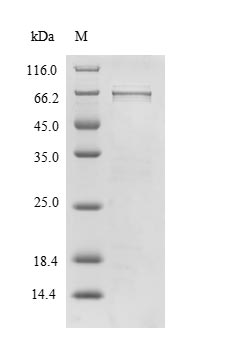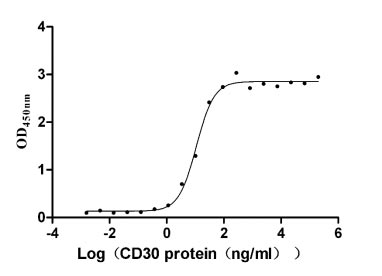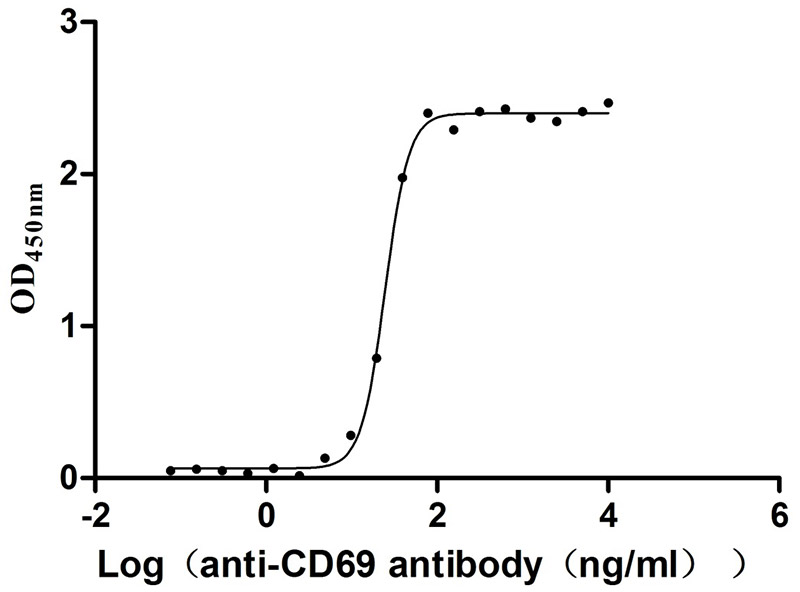Recombinant Thioredoxin-interacting protein (TXNIP)
-
货号:CSB-CF880966HU
-
规格:¥5028
-
图片:
-
其他:
产品详情
-
纯度:Greater than 90% as determined by SDS-PAGE.
-
基因名:
-
Uniprot No.:
-
别名:TXNIP; VDUP1; Thioredoxin-interacting protein; Thioredoxin-binding protein 2; Vitamin D3 up-regulated protein 1
-
种属:Homo sapiens(Human)
-
蛋白长度:Full Length
-
来源:in vitro E.coli expression system
-
分子量:59.7kDa
-
表达区域:1-391aa
-
氨基酸序列MVMFKKIKSFEVVFNDPEKVYGSGEKVAGRVIVEVCEVTRVKAVRILACGVAKVLWMQGSQQCKQTSEYLRYEDTLLLEDQPTGENEMVIMRPGNKYEYKFGFELPQGPLGTSFKGKYGCVDYWVKAFLDRPSQPTQETKKNFEVVDLVDVNTPDLMAPVSAKKEKKVSCMFIPDGRVSVSARIDRKGFCEGDEISIHADFENTCSRIVVPKAAIVARHTYLANGQTKVLTQKLSSVRGNHIISGTCASWRGKSLRVQKIRPSILGCNILRVEYSLLIYVSVPGSKKVILDLPLVIGSRSGLSSRTSSMASRTSSEMSWVDLNIPDTPEAPPCYMDVIPEDHRLESPTTPLLDDMDGSQDSPIFMYAPEFKFMPPPTYTEVDPCILNNNVQ
Note: The complete sequence including tag sequence, target protein sequence and linker sequence could be provided upon request. -
蛋白标签:N-terminal 6xHis-SUMO-tagged
-
产品提供形式:Liquid or Lyophilized powder
Note: We will preferentially ship the format that we have in stock, however, if you have any special requirement for the format, please remark your requirement when placing the order, we will prepare according to your demand. -
缓冲液:Lyophilized from Tris/PBS-based buffer, 6% Trehalose, pH 8.0
-
储存条件:Store at -20°C/-80°C upon receipt, aliquoting is necessary for mutiple use. Avoid repeated freeze-thaw cycles.
-
保质期:The shelf life is related to many factors, storage state, buffer ingredients, storage temperature and the stability of the protein itself.
Generally, the shelf life of liquid form is 6 months at -20°C/-80°C. The shelf life of lyophilized form is 12 months at -20°C/-80°C. -
货期:Basically, we can dispatch the products out in 1-3 working days after receiving your orders. Delivery time may differ from different purchasing way or location, please kindly consult your local distributors for specific delivery time.Note: All of our proteins are default shipped with normal blue ice packs, if you request to ship with dry ice, please communicate with us in advance and extra fees will be charged.
-
注意事项:Repeated freezing and thawing is not recommended. Store working aliquots at 4°C for up to one week.
-
Datasheet & COA:Please contact us to get it.
相关产品
靶点详情
-
功能:May act as an oxidative stress mediator by inhibiting thioredoxin activity or by limiting its bioavailability. Interacts with COPS5 and restores COPS5-induced suppression of CDKN1B stability, blocking the COPS5-mediated translocation of CDKN1B from the nucleus to the cytoplasm. Functions as a transcriptional repressor, possibly by acting as a bridge molecule between transcription factors and corepressor complexes, and over-expression will induce G0/G1 cell cycle arrest. Required for the maturation of natural killer cells. Acts as a suppressor of tumor cell growth. Inhibits the proteasomal degradation of DDIT4, and thereby contributes to the inhibition of the mammalian target of rapamycin complex 1 (mTORC1).
-
基因功能参考文献:
- Using oxygen-glucose deprivation and reoxygenation (OGD/R) to create a cell model of hepatic I/R injury, we found that the mRNA and protein expression levels of TXNIP were upregulated in HL7702cells exposed to OGD/R. PMID: 29852169
- Expression of TXNIP2 isoform, not TXNIP1, is upregulated in leukocytes of patients with acute myocardial infarction. PMID: 30034557
- Thioredoxin-interacting protein (TXNIP) is highly induced in retinal vascular endothelial cells under diabetic conditions. Data (including data from studies using knockout mice) suggest that TXNIP in retinal vascular endothelial cells plays role in diabetic retinal angiogenesis via VEGF/VEGFR2 and Akt/mTOR signaling. (VEGFR2 = vascular endothelial growth factor receptor-2) PMID: 29203232
- miR-20a could negatively regulate TLR4 and NLRP3 signaling to protect human aortic endothelial cells from inflammatory injuries. PMID: 29653364
- Results found the mRNA level of TRX-1 was significantly decreased (p<0.005), while the mRNA levels of TBP-2, COX-2, and TNF-alpha were significantly increased in the placentas in preeclampsia when compared to the normal group. PMID: 29999276
- Consistent with its enhanced expression in Laron syndrome, we provide evidence that TXNIP gene expression is negatively regulated by IGF1. PMID: 29339473
- TXNIP contributes to the dysregulation of tubular autophagy and mitophagy in diabetic nephropathy through activation of the mTOR signaling pathway. PMID: 27381856
- This study thus characterizes ERK-mediated suppression of TXNIP as a presently unreported mechanism by which ap junctions regulate cell behaviors. PMID: 28694028
- Results indicate an internal ribosome entry sites (IRESes) within the thioredoxin-interacting protein (TXNIP) protein; 5' untranslated region (5'UTR), and regulatory IRES trans-acting factors. PMID: 29378331
- The data of this study suggested that TXNIP blocked autophagic flux and induced alpha-synuclein accumulation through inhibition of ATP13A2. PMID: 28755477
- Compared with normal tissues, TXNIP expression was significantly decreased in human breast cancer tissues and canine mammary tumors, along with tumor progression. PMID: 29524408
- This finding suggested statistically significant role of interaction of TXNIP and AF1q polymorphisms (TXNIP-rs2236566, TXNIP-rs7211, and AF1q-rs2769605) in schizophrenia susceptibility. PMID: 27510506
- summarize the current state of our understanding of TXNIP biology, highlight its role in metabolic regulation and raise critical questions that could help future research to exploit TXNIP as a therapeutic target PMID: 28137209
- intracellular TXNIP protein is a critical regulator of activation of the fructose-induced NLRP3 inflammasome PMID: 28326454
- This study provides insight into the molecular mechanisms of TXNIP overexpression in liver cancer cell survival and apoptosis and indicated that TXNIP may be a novel promising agent for liver cancer treatment. PMID: 28440491
- Study showed that the expression of TXNIP was significantly increased in RNF2 knockdown prostate tumor cells and that TXNIP is an important downstream target of RNF2. PMID: 28029659
- Depletion of glycolytic intermediates led to a consistent decrease in TXNIP expression in response to 1,25(OH)2D3, an effect that coincided with the activation of AMPK signaling and a reduction in c-MYC expression. PMID: 28651973
- We found no evidence of decreased TXNIP DNA methylation or increased gene expression in metabolic target tissues of offspring exposed to maternal diabetes. Further studies are needed to confirm and understand the paradoxical SAT TXNIP DNA methylation and gene expression changes in O-GDM subjects PMID: 29077742
- the association of TXNIP (thioredoxin-interacting protein) with NLRP3 induced by ROS promoted NLRP3 inflammasome activation in senescent HUVEC endothelial cells PMID: 28064010
- histone acetylation serves as a key regulator of glucose-induced increase in TXNIP gene expression PMID: 27989964
- thioredoxin-interacting protein deficiency alleviates diabetic renal lipid accumulation through regulation of Akt/mTOR pathway PMID: 27497988
- High expression of TXNIP indicates a lower pathological grade of meningnioma, and is also associated with longer recurrence-free time. PMID: 28243945
- All-trans retinoic acid plays a key role in inhibition of hepatic stellate cell activation via suppressing TXNIP expression, which reduces oxidative stress levels. PMID: 28322443
- Study shows that TXNIP expression is down-regulated in new Multiple Sclerosis (MS) patients compared to controls and might be implicated in pathogenesis of the disease. PMID: 28844667
- TXNIP Single nucleotide polymorphisms may individually and cumulatively affect CAD risk through a possible mechanism for regulating TXNIP expression and gene-environment interactions. PMID: 27470124
- Taken together, our results firstly reveal that TMAO induces inflammation and endothelial dysfunction via activating ROS-TXNIP-NLRP3 inflammasome, suggest a likely mechanism for TMAO-dependent enhancement in atherosclerosis and cardiovascular risks. PMID: 27833015
- results suggest that TXNIP is required early in the apoptotic-inducing pathway resulting from r-Moj-DM binding to the alphav integrin subunit PMID: 27567705
- Hypoxia suppresses thioredoxin binding protein-2 gene expression, which may ultimately alter placental development. PMID: 27762463
- Heme oxygenase rs2071749 polymorphism was positively associated with obesity in Mexicans. PMID: 27274779
- These data identify novel Txnip protein interactions. PMID: 27437069
- Glucose exerts strong stimulatory effects on activation histone marks while having inhibitory effects on repression marks in the promoter of the TXNIP gene, and this was associated with a marked increase in expression of the proinflammatory gene in kidney. PMID: 26806835
- No evidence that SNPS in TXNIP has effect, but the rs4485648 polymorphism of the TrxR2 gene might exert an independent effect on the development of Diabetic retinopathy. PMID: 26763822
- An association has been found between the TXNIP gene methylation pattern and type 2 diabetes mellitus in ischemic stroke patients through epigenetic mechanisms, related to sustained hyperglycemia levels with HbA1c >/= 7%. PMID: 26643952
- These findings thereby provide new mechanistic insight into the regulation of TXNIP and beta-cell biology and reveal novel links between proinflammatory cytokines, carbohydrate response element binding protein-mediated transcription, and microRNA signaling. PMID: 26858253
- The crystal structure of the complex between a phosphorylated PPxY motif of TXNIP and the SH2 domain of Vav2 reveals a conserved recognition mechanism. PMID: 26919541
- Activation of the miR-373-TXNIP-HIF1alpha-TWIST signaling axis is correlated with a worse outcome in patients with breast cancer. PMID: 26196741
- Metformin down-regulates high-glucose-induced TXNIP transcription by inactivating ChREBP and FOXO1 in endothelial cells, partially through AMP-activated protein kinase activation PMID: 26147751
- Foam cell-released 4-hydroxnonenal activates PPARdelta in Vascular endothelial cells, leading to increased TXNIP expression and consequently to senescence. PMID: 25754218
- our data support the hypothesis that TXNIP is an effective target for the treatment of breast cancer. PMID: 25812606
- Expression of TXNIP was up-regulated in all three NSCLC cell lines. PMID: 25854388
- Data identify the metastasis suppressor TXNIP as new target of miR-224/miR-452 that induces feedback inhibition of E2F1 and show that miR-224/452-mediated downregulation of TXNIP is essential for E2F1-induced EMT and invasion PMID: 25341426
- HG-induced NADPH oxidase activation is driven by TXNIP which subsequently triggers NALP3 inflammasome activation in podocytes and ultimately led to podocyte injury PMID: 25834832
- Suggest that TXNIP plays a critical role in anti-Her-1/Her-2 treatment and may be a potential prognostic marker in breast cancer. PMID: 25605021
- The expression of TXNIP was significantly higher in normal-weight type- 2 diabetic patients than in obese ones. PMID: 25726203
- The inhibition of TRX by TXNIP is mediated by an intermolecular disulphide interaction resulting from a novel disulphide bond-switching mechanism. This bond dissociates in the presence of high concentrations of reactive oxygen species. PMID: 24389582
- The protein expression level of TXNIP was negatively correlated with the level of miR-373 in MCF-7 cells and in breast cancer tissue of various migration and invasion abilities. TXNIP was regulated by miR-373. PMID: 26122224
- data suggest that loss of the p53 tumor suppressor cooperates with Mychigh/TXNIPlow-driven metabolic dysregulation to drive the aggressive clinical behavior of TNBC. PMID: 25870263
- diabetes was associated with a >30-fold increase in TxnIP gene expression and a 17 % increase in TxnIP protein expression. PMID: 24925443
- TXNIP has been discovered to control pancreatic B-cell microRNA expression, B-cell function, and insulin production. [Review] PMID: 24911120
- regulatory relationship between mTOR and the MondoA-TXNIP axis that we propose contributes to glucose homeostasis PMID: 25332233
显示更多
收起更多
-
亚细胞定位:Cytoplasm.
-
蛋白家族:Arrestin family
-
数据库链接:
HGNC: 16952
OMIM: 606599
KEGG: hsa:10628
STRING: 9606.ENSP00000358323
UniGene: Hs.533977
Most popular with customers
-
Recombinant Human Tumor necrosis factor ligand superfamily member 8 (TNFSF8), partial (Active)
Express system: Mammalian cell
Species: Homo sapiens (Human)
-
Recombinant Human B-lymphocyte antigen CD20 (MS4A1)-VLPs (Active)
Express system: Mammalian cell
Species: Homo sapiens (Human)
-
Recombinant Mouse Retinol-binding protein 4 (Rbp4) (Active)
Express system: Mammalian cell
Species: Mus musculus (Mouse)
-
Recombinant Human Interleukin-17A (IL17A) (T26A) (Active)
Express system: Baculovirus
Species: Homo sapiens (Human)
-
Recombinant Human Early activation antigen CD69 (CD69), partial (Active)
Express system: Mammalian cell
Species: Homo sapiens (Human)
-
Recombinant Human Transferrin receptor protein 1 (TFRC), partial (Active)
Express system: Mammalian cell
Species: Homo sapiens (Human)
-
Recombinant Human Cadherin-17 (CDH17), partial (Active)
Express system: Mammalian cell
Species: Homo sapiens (Human)
-
Recombinant Human Oncostatin-M (OSM), partial (Active)
Express system: Mammalian cell
Species: Homo sapiens (Human)






-AC1.jpg)














